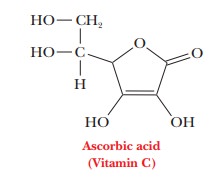Chapter: Biochemistry: Carbohydrates
Vitamin C Is Related to Sugars
Vitamin C Is
Related to Sugars
Vitamin C (ascorbic acid) is an unsaturated lactone with a
five-membered ring structure. Each carbon is bonded to a hydroxyl group, except
for the carboxyl carbon that is involved in the cyclic ester bond. Most animals
can synthesize vitamin C; the exceptions are guinea pigs and primates,
including humans. As a result, guinea pigs and primates must acquire vitamin C
in their diet. Air oxidation of ascorbic acid, followed by hydrolysis of the
ester bond, leads to loss of activity as a vitamin. Consequently, a lack of
fresh food can cause vitamin C deficiencies, which, in turn, can lead to the
disease scurvy. In this disease, defects in collagen structure cause skin
lesions and fragile blood vessels. The presence of hydroxyproline is necessary
for collagen stability because of hydrogen-bonded cross-links between collagen
strands. Ascorbic acid, in turn, is essential for the activity of prolyl
hydroxylase, which converts proline residues in collagen to hydroxyproline.
Lack of ascorbic acid eventually leads to the fragile collagen responsible for
the symptoms of scurvy.
The British navy introduced citrus fruit into the diet of sailors
in the 18th century to prevent scurvy during long sea voyages, and many people
still consume citrus fruit for its vitamin C.
Potatoes are another important source of vitamin C, not because
potatoes contain a high concentration
of ascorbic acid but because we eat so many potatoes.

Related Topics